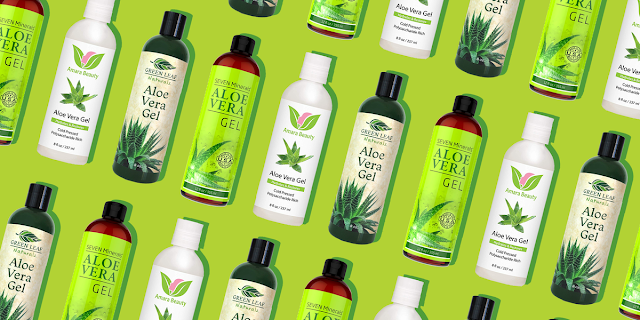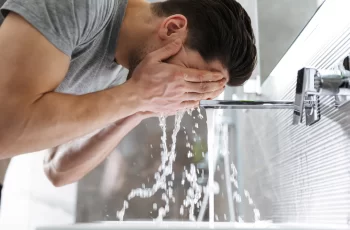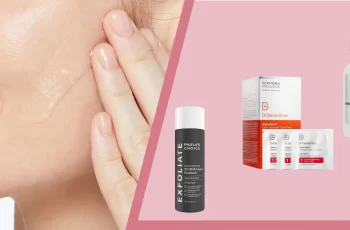Avoiding adverse reactions to skincare products
We have all experienced that moment: the moment when you “reward” yourself with a new skincare product. The excitement is overwhelming, but then you realize that the product is not for you and over time or you may
have an adverse skin reaction immediately after use.
You may wonder why this happens and may feel that it is your own fault, but surprisingly, there are some reasons for these reactions that we are sharing with you now.
What causes skin reactions to products?
1. Using products that are not suitable for your skin type – The most common problem is using products that are not suitable for your skin type.
For example, if you are a dry skin type and use an oil-controlling, oil-free formula, your skin may become dry, tight, and sometimes red. The same is true for oily skin types who use heavy creams that clog their pores and
cause breakouts. You should know your skin type before buying skincare products.
2. Allergies to formula ingredients – Another common problem is allergies to certain ingredients in the product formula. This reaction depends on you and your skin and does not mean that the product itself is poorly made.
But this also doesn’t mean the more money you spend on a product, the better, as an allergy to an ingredient or mixture of ingredients can still be present in the skin. An easy way to find out which ingredient might be to blame is to compare the ingredient list to products you already use and see if there are any differences. If you have other concerns, a visit to a dermatologist may also help.
3. Using a facial scrub that is too irritating to the skin – Some people react to using facial scrubs with redness and sometimes small cuts and scrapes. If this happens, stop using the product immediately. Facial peels can be used for
There are different ways to formulate them, and many people choose to use natural sources such as fruit pits and nut shells.
They are great for removing dead skin cells and dirt, and can have sharp, jagged parts that can damage the skin. White pumice is a safer option because the particles are smooth and gentler on the skin.
4. Overusing strong products – When it comes to anti-aging, we sometimes go overboard with strong products. Retinol is an ingredient that often causes many problems. If you don’t gradually incorporate them into your skin care routine, reactions like redness, burning sensations, and flaking may occur.
To prevent such reactions, you should use the product once a week in the evening. Then over time, allow your skin to be exposed to this powerful product. This method can also be used with other ingredients like vitamin C and
salicylic acid can be used.
5. Improper product formulation – When it comes to skincare, formulation is everything, and using products with too many irritating, tenderizing, and heavily scented ingredients can cause serious problems. The product may
work well initially, but over time, a skin reaction may occur. While scented skincare products are great to use, overuse can have a negative impact on the skin, causing dryness, redness, and pain.
Ultimately, your skin may simply be allergic – For some people, their skin allergy may be easy to understand, but for others, it may come in waves, sometimes being a problem and sometimes not. If you think your skin is irritated, it’s best to do a patch test 24 hours before using the product, especially before using it all over your face.
How to prevent unwanted skin reactions. Here are some tips and tricks to prevent adverse reactions to skincare products. Do: Take the time to understand your skin type and choose products with the right ingredients to nourish and care for your skin.
Make sure to note any reactions you experience when using new skincare products. Over time, you can learn which ingredients don’t work well with your skin.
Slowly introduce powerful ingredients like AHAs, BHAs, and retinols into your routine. This gives your skin enough time to adjust to it without reacting. Test any new product for at least 24 hours to make sure it’s safe for all skin types.
Try to examine your own daily habits to identify products that may be causing these reactions. Start by not using a cleanser, then a serum, then a moisturizer, and so on. This will make it clear which products may be causing the problem.
Don’t: Don’t focus too much on the price of the product. Just because a product is more expensive doesn’t mean it’s more expensive. It’s better that way because it may still contain ingredients you’re allergic to. Don’t forget to check your daily SPF to see if it’s related to any reactions you may be experiencing.
Don’t worry if you’re suddenly allergic to a product you’ve been using for a while. Sometimes the skin just needs a change. Don’t keep using something that causes a reaction just because someone else has used it. Comments or receive
results.
Preventing side effects from skincare products is not easy. It takes a lot of effort and time to find the products and formulas that work for you and give you the skin you crave. Just like a cake recipe
you need to combine the right ingredients to create a masterpiece!
DQH Knowledge drop: In your 20s, your skin cell turnover decreases. (Cell turnover is a key component in keeping your skin youthful.) You know what else slows down? Your collagen production. Starting in your 20s, collagen decreases by about 1 percent per year. Should you want to prevent fine lines and wrinkles, start by eliminating behaviors that contribute to premature aging. “If it’s bad for you, it’s bad for your skin,” says dermatologist Michel Somenek.
“Cigarette smoking reduces blood flow to the skin and causes premature wrinkling and a dull skin texture. Making the repeated pursed motion to inhale can also cause smoker’s lines. Alcohol and recreational drugs are toxins for the skin that damage its cellular structure and DNA,” Somenek tells us. “The faster you eliminate vices while you are young, the better chance your skin and body have to recuperate.” Also, adopting an anti-aging routine in your 20s is key. After all, the best offense is a good defense. We spoke to Somenek and experts Joshua Ross and Audrey Kunin to find out more.
Keep reading for the best anti-aging products for your 20s, according to skincare professionals.
Sunscreen
“We all know that the sun is the number one cause of skin aging and starting the prevention in your 20s is very important,” Ross says. “The majority of your sun damage won’t start to appear until you’re in your 30s, so don’t wait until you see it surface or you’ll be behind the curve. Stay ahead of it with a good-quality zinc-based sunscreen worn daily.”
Farmacy Green Defense Daily Mineral Sunscreen
An invisible sunscreen with SPF 30, plus botanical extracts meant to protect skin with tons of antioxidants. Bonus: It’s clean and fine to use under makeup.
Bareminerals Complexion Rescue™ Tinted Moisturizer Broad Spectrum SPF 30
Although we recommend you use your SPF and moisturizer separately, we also understand moments when you don’t have time or energy for that extra step. For those times, this bareMinerals moisturizer is a great thing to have on hand.
Vitamin C Serum
“A great introduction to anti-aging is to start with a vitamin C serum in your morning skincare routine,” Ross says. “It’s a powerful antioxidant that will neutralize free radicals and brighten the skin.” He adds that it’s a great way to counteract the effects of the sun’s harmful rays, which, as previously mentioned, are among the biggest causes of premature aging.
Drunk Elephant C-Firma™ Vitamin C Day Serum
The Drunk Elephant C-Firma is a lightweight serum that promises to give skin a glow by combining the brightening powers of vitamin C with ferulic acid, l-ascorbic acid, and vitamin E. The included sodium hyaluronate is meant to replace hydration loss, so you shouldn’t have to deal with any irritation.
Sunday Riley C.E.O. Rapid Flash Brightening Serum
This potent serum is jam-packed with vitamin C (15 percent, to be exact), which means it’s a potential superstar at both brightening skin and dousing it in antioxidants.
Peptides
Using peptides on your skin has many benefits, says Somenek. “The skin barrier is what defends the body against pollution, UV rays, bacteria, and toxins. It can be damaged by several everyday factors. Using topical peptides aids in building a stronger barrier,” he says. “Peptides comprise elastic fibers, which are a type of protein. These fibers help to make skin appear taut and firm. Peptides can also help repair damaged skin, relieve inflammation, and even out skin tone. Some peptides can kill acne-causing bacteria that is common in 20-somethings.”
Kunin agrees, saying, “Peptides are an excellent entry point for supporting collagen.” She recommends looking for face and eye treatments that contain these collagen-boosting powerhouses.
Charlotte Tilbury Magic Eye Rescue Cream
This Charlotte Tilbury super-emollient eye cream has a base of coconut oil and shea butter (read: it’s incredibly hydrating). Botanicals plus peptides are meant to help reduce dark circles and boost collagen, respectively.
This creamy moisturizer serves up potent collagen-boosting peptides and pycnogenol, and antioxidant-rich vitamin C. “Instead of sitting on top of the skin, peptides penetrate the outer layer so they go deep. The ‘signals’ they send tell the cells to produce elastin and collagen, which are needed for youthful-looking skin,” explains Somenek.
At-Home Peel Pads
Remember that skin cell turnover fiasco we talked about earlier? One way to help support it is by exfoliating. “Exfoliation is important to help keep skin fresh and luminous,” Kunin says. She recommends using at-home peel pads as an easy and effective way to exfoliate.
“The goal in your 20s is to fight the slowing pace of cell turnover. It is wise to use products that gently exfoliate, yet still remove oil and other impurities. Products that have Alpha Hydroxy Acids (AHA) or Beta Hydroxy Acids (BHA) are a good choice.”
According to Somenek, you should only exfoliate two to three times a week. “People of all ages are guilty of over-exfoliating and that can be too much of a good thing,” he says.
Dermadoctor Kakadu C Intensive Vitamin C Peel Pad
A few swipes of this Derma Doctor powerful peel pad promise to leave your skin glowing and smooth, thanks to the seven (yes, seven) types of chemical exfoliants, including AHA and BHA. It also contains vitamin C via Kakadu plum extract for added brightening and antioxidant protection.
KEY INGREDIENTS Kakadu plum extract is sourced from the Kakadu plum, a fruit grown in northern Australia. It contains vitamin C, which restores the skin’s natural barrier, increases collagen production, and soothes irritation.
Dr. Dennis Gross Skincare Alpha Beta® Universal Daily Peel Pads
These are the gold standard of peel pads, with a cult following and over 900 five-star reviews on Sephora. They’re easy to use and contain a blend of anti-aging exfoliating acids.
Emollient Night Cream
“In your 20s, you need to start upping the hydration in your skincare routine. You may have been cautious of over-moisturizing because of acne in your teens, but as you enter your 20s, your skin transitions and becomes drier,” Ross says. “I recommend an emollient night cream added into your evening skincare regimen.”
“Twenty-somethings need to make sure that they are not using creams that will clog their pores and cause excess oil production,” says Somenek. Opt for non-comedogenic products.
Cerave Skin Renewing Night Cream
One great choice is the CeraVe Skin Renewing Night Cream, which is a non-comedogenic night cream that leaves skin soft and glowy. It combines the moisturizing powers of ceramides and hyaluronic acid.
RoC Retinol Correxion Max Hydration Creme
“The best night cream ingredients contain retinol, benzoyl peroxide, and/or salicylic acid or hyaluronic acid. The goal is to moisturize, yet remove excess oil,” says Somenek. This Roc Retinol Correxion cream fits the bill as it contains both hyaluronic acid and retinol so it promises to moisturize while also being non-comedogenic.



